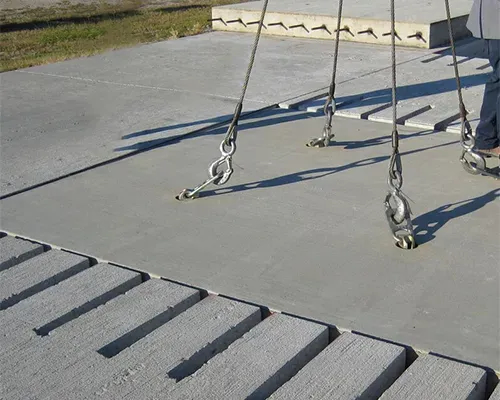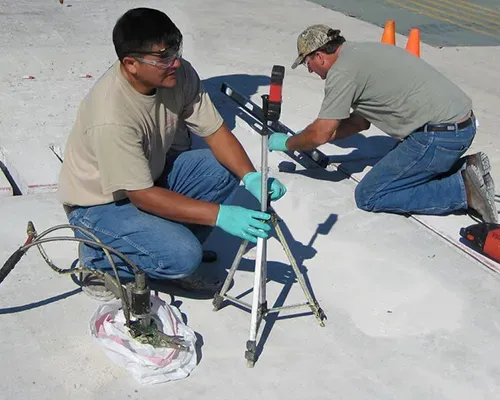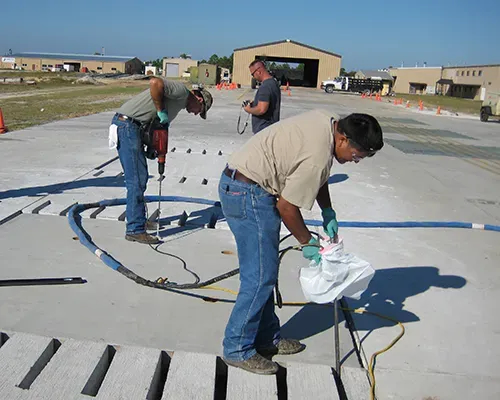Best Precast Concrete Installation Method Confirmed

Problem
Many airfield pavements are constructed with Portland Cement Concrete (PCC). When PCC slabs become severely deteriorated, a quick repair is needed to safely restore flight operations in the shortest time possible. Using precast concrete panels is one way to expediently repair airfield damage, but there are several combinations of leveling materials and installation techniques that can be used. The Air Force Research Laboratory (AFRL) at Tyndall Air Force Base in Florida contracted URETEK to assist in a comparative study to determine which precast concrete panel installation method would be best.
Analysis
Each method the study investigated was comprised of a variable leveling material (high density polymer foam or flowable fill) and installation technique (conventional injection, deep injection, or flowable fill). The study determined the effectiveness of each method of panel installation against three mechanistic measures: the load transfer efficiency, joint stiffness, and deformation energy dissipated through the pavement foundation.

Solution
Three 9-inch thick precast concrete repair panels were installed in the 12-inch thick PCC test pad. The precast repair panels contained steel reinforcement to prevent damage during the transportation and installation operations and to mitigate thermal cracking. In the conventional injection tests, URETEK placed high density polymer (HDP) directly under a precast repair panel to stabilize, lift, and level the panel. In the deep injection tests, URETEK employed its URETEK Deep Injection® (UDI) process to place HDP into the underlying s oils at 36 inches below the pavement surface.
Result
The results of the study were published (Ashtiani, et al. “Precast Concrete Panels for Rapid Repair of Airfield Rigid Pavements”) and briefed during the 90th Annual Meeting of the Transportation Research Board in Washington, DC, in January 2011. Precast panels installed with HDP performed better than those installed with flowable fill as a leveling material. Precast panels installed with UDI performed better than those installed with conventional injection. Therefore, the results of the study indicate that combining an HDP leveling material with UDI is the best method to install precast concrete repair panels.
URETEK Deep Injection® (UDI)
Widely referenced throughout our industry, UDI involves the injection of structural polymer into base and subgrade soils to increase the load bearing capacity. This is achieved by injecting the polymer through small holes drilled directly through the pavement structure to depths determined by site-specific analysis. Our URETEK 486 Star® material flows easily into voids and weak zones within the soil mass below. Through a controlled chemical reaction, the expanding polymer compacts surrounding soils and applies a controlled pressure on targeted areas of the affected pavement above. If needed, a multi-injection design plan is utilized to gently return the pavement to its original grade. The composite material quickly cures into a strong, dimensionally stable, and water-resistant geo-material, providing years of reliable service.
URETEK 486 Star®
URETEK 486 Star® polymer is a two-component, high-density, expanding thermoset polyurethane system. It was developed to be the ideal solution for under-sealing, void filling, lifting of settled pavement, stabilization and stiffening of weak soils, and for encapsulating and sealing buried infrastructure. URETEK 486 Star® is environmentally inert, non-toxic, and resists underground water erosion or weakening due to its industry-leading hydrophobic properties.
